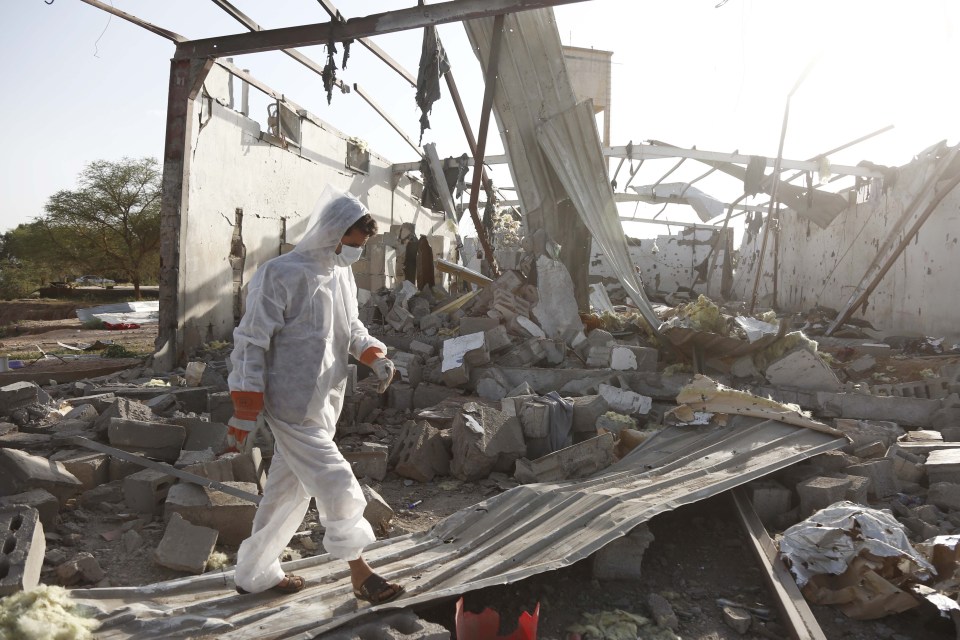THE UK has joined US forces in launching a fresh strike on a Houthi target in Yemen.
RAF Typhoon jets, backed by Voyager air-to-air refuelling tankers, hit several drone manufacturing buildings 15 miles south of the capital Sanaa.
GettyA destroyed building in the northern Yemeni city of Saada after an attack by US warplanes on Tuesday[/caption]
GettyBritain’s RAF Typhoon jets helped US strike Houthi targets in Yemen (file photo)[/caption]
AFPYemenis check the rubble of a building hit in US strikes in the country’s northern province of Saada[/caption]
Forces used Paveway IV precision-guided bombs to hit the terror sites on Tuesday night.
The strike marks Britain’s first involvement in the new phase of the America’s ‘Operation Rough Rider’ against the Iran-backed group.
The US-led campaign has seen more than 800 strikes since mid-March.
The Ministry of Defence said the strike was carried out after dark “to allow the targets to be prosecuted with minimal risk to civilians or non-military infrastructure.”
Posting on X, the MoD said: “Overnight, @RoyalAirForce Typhoons conducted strikes against a Houthi military target in Yemen to defend freedom of navigation, strengthen regional stability, protect UK economic security, and reduce the Houthis’ capacity to launch further attacks.”
Defence Secretary John Healey said: “This government will always act in the interests of our national and economic security.
“Royal Air Force Typhoons have successfully conducted strikes against a Houthi military target in Yemen and all UK aircraft and personnel have returned safely to base.
“We conducted these strikes, supported by the US, to degrade Houthi capabilities and prevent further attacks against UK and international shipping.”
Mr Healey added: “A 55% drop in shipping through the Red Sea has already cost billions, fuelling regional instability and risking economic security for families in the UK.”
The MoD said “careful intelligence analysis” had identified a cluster of buildings used by the Houthis to manufacture drones used to attack ships in the Red Sea and Gulf of Aden.
While the US has so far provided few details about its latest operations, Britain’s move marked a rare and detailed public explanation for the joint strike.
The UK, however, offered no information on the damage inflicted or potential casualties, and US Central Command has not yet acknowledged the operation.
The Houthis, who have controlled Sanaa since 2014, reported multiple strikes around the capital as well as in the rebel stronghold of Saada.
It comes after a US strike reportedly hit a detention centre for African Migrants, killing at list 68 people, according to Sky News.
Another American airstrike on April 18 reportedly killed 74 at the Ras Isa fuel port.
Staggering nighttime footage, filmed by Turkish sailors onboard an oil tanker in the Red Sea, showed huge fireballs erupting across the port.
Blazing orange flames ripple across the water before shooting up into the sky, forming a giant wall of fire.
Under Donald Trump’s renewed leadership, the US has stepped up attacks on the Houthis — the last militant group in Iran’s so-called Axis of Resistance capable of regularly striking Israel.
The US military confirmed it has carried out over 800 airstrikes in just 44 days as part of Trump’s ferocious campaign, killing hundreds of Houthi terrorists and several senior commanders.
American forces are operating from two aircraft carriers in the region: the USS Harry S. Truman in the Red Sea and the USS Carl Vinson in the Arabian Sea.
Who are the Houthis?
THE Houthi rebels have spent months terrorising the Red Sea by launching persistent missile and drone attacks on vessels and warships – but who are they?
The Shia militant group, which now controls large swaths of Yemen, spent over a decade being largely ignored by the world.
However, since the outbreak of the Israel-Hamas war, they sprung from relative obscurity to holding roughly £1trillion of world trade hostage – turning one of the world’s busiest shipping lanes into an active warzone.
Their warped battle cry is “Death to America, Death to Israel, curse the Jews and victory to Islam”.
Why are they attacking ships?
After the October 7 massacre, Houthis began launching relentless drone and missile attacks on any ships – including warships – they deem to be connected with Israel in solidarity with their ally, Hamas.
In reality, they targeted commercial vessels with little or no link to Israel – forcing global sea traffic to largely halt operations in the region and sending shipping prices around the world soaring.
The sea assaults added to the carnage in the Middle East tinderbox as intense ripples from Israel’s war in Gaza were felt across the region – with Iran accused of stoking the chaos.
The Houthi chiefs pledged their Red Sea attacks would continue until Israel stopped its offensive in Gaza.
The group’s chiefs have previously said their main targets are Israel, and its allies the US and Britain.
And despite repeated threats from the West and joint US and UK strikes blitzing their strongholds in Yemen – Iran’s terror proxy appears undeterred.
The UK and US have hit Houthi bases as recently as this month after the terror group once again targeted boats in the shipping lane.
Israel has also hammered the group with airstrikes, reportedly hitting oil storage tanks at the port in Al Hudaydah.

